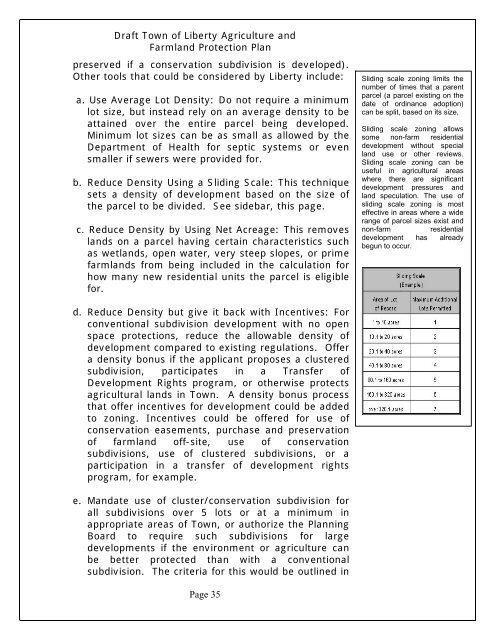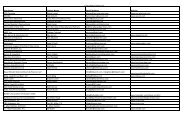Agriculture and Farmland Protection Plan - Town of Liberty
Agriculture and Farmland Protection Plan - Town of Liberty
Agriculture and Farmland Protection Plan - Town of Liberty
You also want an ePaper? Increase the reach of your titles
YUMPU automatically turns print PDFs into web optimized ePapers that Google loves.
Draft <strong>Town</strong> <strong>of</strong> <strong>Liberty</strong> <strong>Agriculture</strong> <strong>and</strong><br />
Farml<strong>and</strong> <strong>Protection</strong> <strong>Plan</strong><br />
preserved if a conservation subdivision is developed).<br />
Other tools that could be considered by <strong>Liberty</strong> include:<br />
a. Use Average Lot Density: Do not require a minimum<br />
lot size, but instead rely on an average density to be<br />
attained over the entire parcel being developed.<br />
Minimum lot sizes can be as small as allowed by the<br />
Department <strong>of</strong> Health for septic systems or even<br />
smaller if sewers were provided for.<br />
b. Reduce Density Using a Sliding Scale: This technique<br />
sets a density <strong>of</strong> development based on the size <strong>of</strong><br />
the parcel to be divided. See sidebar, this page.<br />
c. Reduce Density by Using Net Acreage: This removes<br />
l<strong>and</strong>s on a parcel having certain characteristics such<br />
as wetl<strong>and</strong>s, open water, very steep slopes, or prime<br />
farml<strong>and</strong>s from being included in the calculation for<br />
how many new residential units the parcel is eligible<br />
for.<br />
Sliding scale zoning limits the<br />
number <strong>of</strong> times that a parent<br />
parcel (a parcel existing on the<br />
date <strong>of</strong> ordinance adoption)<br />
can be split, based on its size,<br />
Sliding scale zoning allows<br />
some non-farm residential<br />
development without special<br />
l<strong>and</strong> use or other reviews.<br />
Sliding scale zoning can be<br />
useful in agricultural areas<br />
where there are significant<br />
development pressures <strong>and</strong><br />
l<strong>and</strong> speculation. The use <strong>of</strong><br />
sliding scale zoning is most<br />
effective in areas where a wide<br />
range <strong>of</strong> parcel sizes exist <strong>and</strong><br />
non-farm<br />
residential<br />
development has already<br />
begun to occur.<br />
d. Reduce Density but give it back with Incentives: For<br />
conventional subdivision development with no open<br />
space protections, reduce the allowable density <strong>of</strong><br />
development compared to existing regulations. Offer<br />
a density bonus if the applicant proposes a clustered<br />
subdivision, participates in a Transfer <strong>of</strong><br />
Development Rights program, or otherwise protects<br />
agricultural l<strong>and</strong>s in <strong>Town</strong>. A density bonus process<br />
that <strong>of</strong>fer incentives for development could be added<br />
to zoning. Incentives could be <strong>of</strong>fered for use <strong>of</strong><br />
conservation easements, purchase <strong>and</strong> preservation<br />
<strong>of</strong> farml<strong>and</strong> <strong>of</strong>f-site, use <strong>of</strong> conservation<br />
subdivisions, use <strong>of</strong> clustered subdivisions, or a<br />
participation in a transfer <strong>of</strong> development rights<br />
program, for example.<br />
e. M<strong>and</strong>ate use <strong>of</strong> cluster/conservation subdivision for<br />
all subdivisions over 5 lots or at a minimum in<br />
appropriate areas <strong>of</strong> <strong>Town</strong>, or authorize the <strong>Plan</strong>ning<br />
Board to require such subdivisions for large<br />
developments if the environment or agriculture can<br />
be better protected than with a conventional<br />
subdivision. The criteria for this would be outlined in<br />
Page 35




